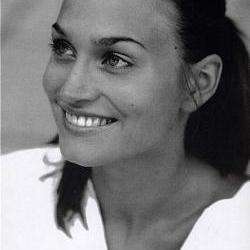Massenet’s Manon is a character inherently difficult to love. Not only does she trade true love with the Chevalier Des Grieux, a man who adores her, in exchange for money and wealth but, having acquired both at his expense, she then seduces him away from his dearly acquired peace and resolve. Both are then landed in trouble with the law as a result of Manon’s obsession with wealth and the high life. Notwithstanding all of this, Des Grieux loves her truly and desperately, continuously going to great lengths to assure her happiness and safety. In order for her to still evoke sympathy, a truly convincing Manon must be strong-willed, yet somehow fragile; innocent, yet completely materialistic. Any soprano wishing to incorporate her has a lot to unpack in this complicated character, and that’s before we’ve even begun to discuss the significant vocal challenges of the role.
Patricia Petibon manages to portray an absolutely charming Manon. She spans the space between innocence and worldliness and remains consistently energetic and delightful. Although vocally I am used to hearing more lyrical voices with more heft than hers in the role, she was vocally expressive and convincing and brought a wonderful fragility to the role which was appreciated. Her “Je suis encore tout étourdie” managed to quickly establish her as both breathlessly overwhelmed and coquettish, and every time she took the stage she drew her audience to her completely. Jean-François Borras was also lovely to listen to as the Chevalier Des Grieux. His voice is one which seems to spin effortlessly on its own, and his capacity for both velvety, light shades of piano and pianissimo, particularly in “En fermant les yeux”, and brilliance and strength in more dramatic moments (the Act IV conclusion, for example) spoke to his considerable artistry and ability. Graf Des Grieux was beautifully rendered through the vocal richness and ripeness of Dan Paul Dumitrescu, and Marcus Eiche gave a strong showing as the gambling, lascivious Lescaut.
The rest of the cast were a bit less convincing, not because of any vocal failings, they all sang very well, but simply because of the questionable direction. Thomas Ebenstein plays a flighty, neurotic Guillot de Morfontaine and the three fashionable “actresses” (here as prostitutes), Poussette (Hila Fahima), Javotte (Stephanie Houtzeel) and Rosette (Juliette Mars) continuously writhe and seduce, all of which grows tiresome long before the end. In general, that was an unfortunate weakness of the production. All the minor characters were directed in stock ways that robbed them of any potential depth. In the first act the characters’ movements took a farcical bent. In the St Sulpice scene, the nuns acted like giggling, fatuous school girls, which was not only simplistic but also went against the grain of the inherent drama and depth which immediately followed. Excepting the nuns, every other woman on stage was dressed and directed like a prostitute. Even the relationship of Manon to her cousin, Lescaut was completely oversexed, which was incongruous with the intent of the libretto and frankly, banal.
Under the baton of Frédéric Chaslin, the Staatsopernorchester played with a great deal of pep, but also drowned out both major protagonists from time to time and did not consistently exhibit the perfect ensemble of which they are capable. The choir was generally excellent, though in the first couple of Acts there were several ensemble issues between orchestra, soloists and ensemble.
Visually, this is not an unattractive production, and some of it is really wonderful. Director Andrei Serban sets it in the 1930s, reflected masterfully in Peter Pabst’s design. The use of framing in the stage design and mélange of video, mirroring, paper cut outs, hung elements and lighting provide several very alluring tableaux. A railway station, a simple but warmly coloured bedroom, a cloister, the streets of Paris and even a gambling hall (my personal favorite) were all expressively and intelligently constructed. I would, however gripe about the design of the final scene, which gave the impression that the powers-that-be had run suddenly out of budget, inspiration or both. An empty stage – still beautifully framed but devoid of any other inanimate object – provides the backdrop to Manon’s death on a heath while waiting to be banished to a faraway land. Upon this constantly moving images – of leaves, branches, water and so on – are projected. These are apparently designed to make the audience nauseous and distract them from the poignant moments of love and loss which are in the course of ensuing. Fortunately, the images fade with time and dark night blessedly descends as Manon and her love express their love and regret and say their final goodbyes.
The costumes are also generally good, but inconsistent. While Manon enjoys opulent and beautifully designed costumes, the minor characters (in particular the women of ill repute – and isn’t Manon supposed to envy them their airs and clothing?) are tawdrily and cheaply garbed in velveteen, synthetics and even a bad leopard print which seems more at home in the 1980s or 90s than in the 1930s.
In short, this production and cast are very much worth a trip to the opera, but we’ll all likely agree that this is not destined to be the must-see show at the Haus am Ring this season.




